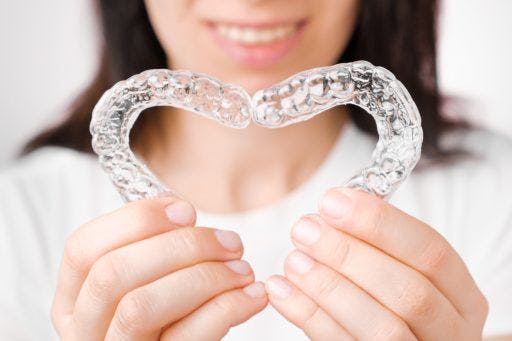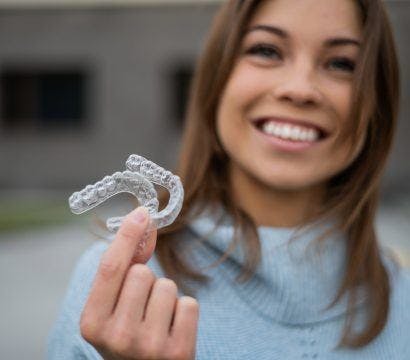So, you’ve decided to straighten your teeth, and are excited to be one step closer to greater smile confidence. With all the options available, you know you want something subtle and convenient. You narrow it down to clear braces and aligners – yet you’re still stumped.
Make the choice easier with this comprehensive guide on clear braces. Learn how they differ from invisible aligners to find the best option for your needs.
What are clear braces?
Clear braces are orthodontic devices designed to correct misaligned teeth. Like traditional braces, they apply pressure on teeth to shift them into their proper positions. However, these “invisible braces” use clear or tooth-coloured brackets, making them blend with your teeth. They’re not entirely invisible, but they’re far less noticeable than metal braces.
Types of clear braces
Technological advances offer several options. Select the type that best fits your needs:
- Clear ceramic braces: These use ceramic material for the brackets, blending seamlessly with the natural colour of your teeth.
- Self-ligating clear braces: These braces use a sliding mechanism to straighten teeth, reducing the need for frequent adjustments.
- Customisable clear braces: Some options allow you to customise the brackets’ appearance and material. Besides ceramic, frosted plastic is also another option.
When to use clear braces
According to the Australian Dental Association, orthodontic devices like braces and clear aligners address a range of alignment and bite issues, including:
To know if you have any of these, take this online smile assessment today.
Risks and benefits of clear braces
Weigh the pros and cons before making your decision:
Benefits of clear braces
- Clear braces are more discreet than metal braces.
- These braces do not interfere with imaging tests. Metal braces can disrupt the process and lead to inaccurate results.
- They feature rounded edges and smoother surfaces, ensuring comfort.
- If you forget to put your aligners in, it could lengthen how long it takes to straighten your teeth. Whereas braces are worn 24/7, potentially reducing treatment time.
- Clear braces are customisable. You can select the material and colour depending on your preferences and budget. Silver wire and clear bands are options to make them even more discreet.
Risks of clear braces
- Clear braces may shift teeth slower than metal brackets and wires.
- The material is more prone to damage and may need frequent repairs. Certain lifestyle activities and diets may make them more susceptible to bracket breakage.
- These braces can stain, possibly affecting your tooth surface and leading to discolouration.
- They may lead to gum sensitivity. These braces may come larger than metal brackets, making cleaning difficult. If your toothbrush does not reach the nooks and crannies, you may experience gum swelling or recession.
- You might still experience irritation to the lips and cheeks, as well as chewing and speaking discomfort.
- Clear braces may cost you more than metal braces.
Clear braces vs. aligners: 7 key differences
Need help deciding? Explore the key differences between clear braces and aligners to make an informed choice.
1. Concealment
Clear braces: Clear braces fall under the traditional category, except they’re much less noticeable because the ceramic brackets (the little squares attached to your teeth) are transparent. Sometimes, the wire also matches the colour of your teeth to blend in more naturally.
Teeth aligners: Clear aligners straighten your teeth like traditional braces but without wires and brackets. One example is ClearCorrect. It offers a premier aligner engineered for precision, comfort, and aesthetics thanks to a unique combination of patented ClearQuartz tri-layer material, high and flat trimline, and scientifically proven clinical features. It corrects your crooked teeth subtly and makes you feel more confident.
2. Comfort
Clear braces: Clear braces tend to rub against the gums, lining of your cheeks, and lips, causing sores and blisters. It might be one drawback for an athlete or anyone who leads a generally active lifestyle.
Teeth aligners: Although aligners come with some soreness, especially during the adjustment period, the overall discomfort is less as the material is smoother than porcelain or ceramic braces.
3. Convenience

Clear braces: Another factor to consider is how much maintenance you’re willing to put in. Clear braces require more frequent visits to your orthodontist. You’ll have two main sessions, bond and debond, when the brackets are put on and removed.
Then, you must book short visits in between to have your braces adjusted, replace missing brackets, or tighten wires. If you’re leaning towards clear braces, you will need to make time for multiple trips to the dental clinic.
Teeth aligners: On the other hand, orthodontists map out the details of your aligners to a tee. For instance, dental clinicians who partner with ClearCorrect use ClearPilot.
This digital treatment planning tool lets the dentist and the patient visualise the outcomes, helping both develop a customised – and the most effective – treatment plans using ClearPilot’s optimised 3D visual interface. This personalisation makes outcomes more predictable, requiring fewer visits.
4. Cleanliness
Clear braces: Clear braces are great for those who want a less hands-on approach because you don’t remove them while eating or brushing your teeth. It also means fewer chances of losing or breaking them. The downside is that cleaning your teeth can be an ordeal as you try to brush through all the nooks and crannies.
Teeth aligners: With aligners, you won’t have to worry about reaching tight spaces between your teeth. You can easily slip them off at any time, allowing you to clean your teeth as usual.
Remember – not being able to clean teeth properly can be frustrating and might lead to dental problems like staining and cavities.
5. Compliance
Clear braces: Once the clear braces are attached to your teeth, you wear them 24/7. This may make them a better choice for younger patients like teenagers, who are more likely to forget or misplace aligners.
Teeth aligners: For aligners to be effective, you must wear them around 18 to 22 hours a day, taking them off only when eating or brushing. Aligners require a higher level of commitment versus braces.
6. Duration

Clear braces: Braces have been a mainstay for so long because of their effectiveness in dealing with more severe conditions. It targets all degrees of malocclusion and corrects gaps big and small. You must keep your braces for one to three years.
Teeth aligners: Do you need to wear clear aligners for longer than braces? Your orthodontist will give you an exact timeline of how long you have to wear your aligners, but treatment can be as short as six to 12 months, depending on the gravity of your misalignment. More extreme cases usually require braces first before transitioning to aligners.
7. Cost
The difference in cost between clear braces and aligners may vary depending on several factors, such as the duration of treatment and fees paid to the manufacturer in the case of aligners.
Generally, the price difference between the two options is insignificant, considering other investments, such as the number of dental visits. However, you might need to replace your aligners as your teeth straighten out. You may also require more aligners depending on the length of your treatment.
So, are aligners better than braces? When it comes down to it, the choice will depend on your individual needs and preferences. Braces are an excellent option if your condition requires a more aggressive approach. Aligners might make a better choice for those who want a more subtle and convenient solution. Whichever treatment you decide on, work with your orthodontist to find your ideal solution and get closer to a more confident smile.



